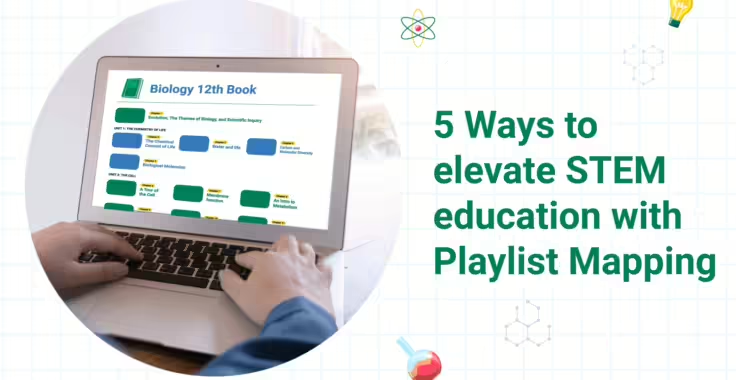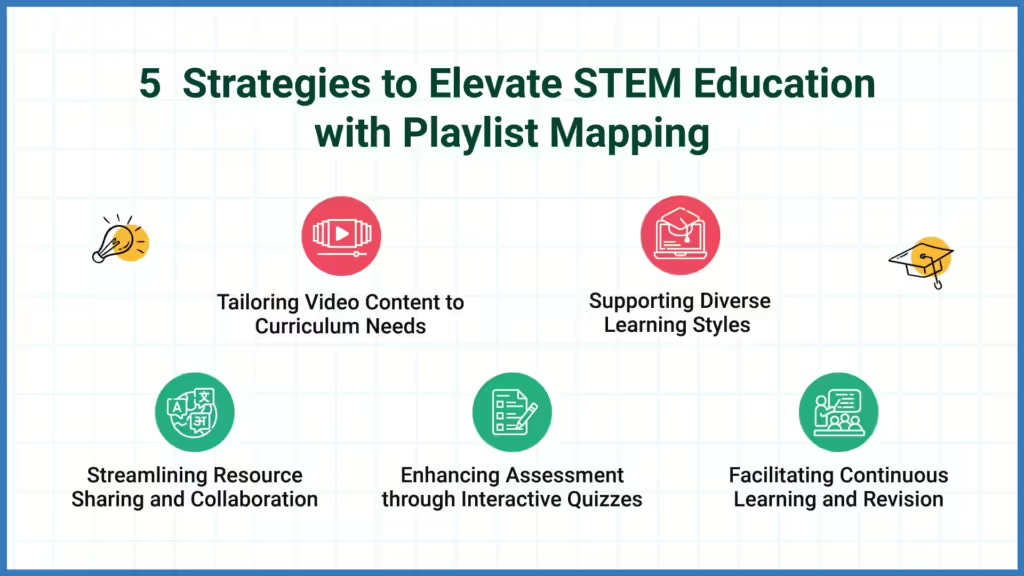
Elevating STEM Education Through Effective Playlist Mapping
In the fast-paced world of science education, high school teachers continually seek innovative methods to enhance student engagement and learning outcomes. One such powerful approach for achieving this is playlist mapping. By organizing educational content into structured sequences, teachers can create more coherent and focused learning journeys for their students, especially in STEM (Science, Technology, Engineering, and Mathematics) disciplines.
Understanding Playlist Mapping in STEM Education
Playlist mapping is a method of organizing science educational content into a structured sequence that aligns with specific teaching objectives. This approach is particularly beneficial in STEM education, where complex scientific concepts require clear and sequential presentation.
So, what is Playlist Mapping? In the context of science education, playlist mapping involves creating a sequence of educational videos, lab experiments, and interactive content that flows logically from one concept to the next. By doing so, this structured approach ensures that students build on their knowledge in a systematic way, which is critical when dealing with subjects like biology, chemistry, and physics.
Moreover, JoVE offers science teachers a way to create playlists tailored to their high school classroom needs. Teachers can add videos, label sections, and organize content by scientific topics, NGSS standards, or chapters, ensuring that the learning journey aligns with curriculum goals. JoVE also offers teacher resources that support educators in finding relevant content aligned to their specific teaching objectives.
Integrating these resources as part of a science video curriculum can significantly enhance the structure and flow of the educational content, making it easier for students to grasp and retain complex scientific concepts
Benefits of Playlist Mapping for STEM Courses
Playlist mapping offers significant benefits for high school science courses, particularly in delivering content efficiently and enhancing student learning outcomes.
First and foremost, playlist mapping ensures that science content is delivered in a structured and coherent manner. For example, a chemistry teacher can sequence videos on chemical bonding, reactions, and stoichiometry, ensuring students grasp foundational concepts before moving on to advanced topics.
Additionally, by providing a structured learning journey, playlist mapping improves learning outcomes. Science students can revisit specific sections as needed, reinforcing their understanding of challenging concepts.
Furthermore, curated playlists break down complex scientific ideas into manageable, digestible parts, making subjects like physics and environmental science more accessible and engaging. JoVE’s extensive library of teacher resources provides additional flexibility, allowing educators to select appropriate content to match their teaching objectives.
Lastly, playlist mapping allows science educators to update and modify content as new discoveries emerge or teaching priorities shift, ensuring that students always receive the most current and relevant information. This adaptability is particularly important when integrating new content into a science video curriculum that evolves with the latest scientific advancements.
5 Key Strategies to Elevate STEM Education with Playlist Mapping
To maximize the impact of playlist mapping in your science classroom, consider these strategies:

1-Tailoring Video Content to Curriculum Needs:
Creating customized playlists ensures that video resources align precisely with your science curriculum, helping reinforce key concepts and standards in subjects like biology, chemistry, and physics. This alignment not only supports curriculum goals but also enhances student engagement and teaching STEM subjects effectively.
2-Supporting Diverse Learning Styles:
Playlists can cater to various learning preferences, helping each student access content in a way that suits them best, whether they are visual, auditory, or kinesthetic learners. By engaging visual learners with video content and allowing kinesthetic learners to engage with experiments, the learning experience becomes more dynamic.
3-Streamlining Resource Sharing and Collaboration:
Use playlists to facilitate easier sharing of teaching resources among educators and collaborative study among students. As a result, this organization ensures that teachers can efficiently distribute materials and enhance teaching STEM strategies across different classes.
4-Enhancing Assessment through Interactive Quizzes:
Embedding interactive quizzes into playlists enhances the assessment of student understanding. Quizzes allow teachers to gauge comprehension immediately after content viewing, and consequently, use the results to identify areas where students may need additional support, adjusting the playlist accordingly.
5-Facilitating Continuous Learning and Revision:
Playlists can be used as ongoing learning tools that science students can access for revision and reinforcement of material. Ultimately, this approach helps students retain information better and perform well in assessments, ensuring all necessary topics are comprehensively covered.
Conclusion: Enhancing STEM Education with JoVE’s Playlist Mapping
Playlist mapping is a powerful method for enhancing STEM education, particularly in science classrooms. By organizing content into structured sequences, educators can improve teaching efficiency and student engagement.
Science teachers are encouraged to experiment with creating their own playlists to see firsthand the improvements in teaching and learning. Therefore, consider exploring JoVE’s video-based science curriculum and extensive teacher resources to start implementing playlist mapping in your classroom today.
Why wait? Sign up for JoVE today to access thousands of science videos, lab simulations, and more. Enhance your teaching and give your students the dynamic learning experiences they need to thrive in today’s world.
Start now for free and access 20 JoVE science videos to see how they can transform your classroom!